From the Blue Oak Nursery….

Directions to Dry Creek Preserve: Located at 35220 Dry Creek Road, Woodlake CA 93286, Located outside of Lemon Cove: From Visalia, travel east on Highway 198. Take Highway 216 toward Woodlake. Follow 216 west 1/2 mile then turn north on Dry Creek Road. Preserve is located two miles up up Dry Creek Road on the right.

[image of clarkia-unguiculata © Barbara Brydolf]
Join the Alta Peak Chapter on September 1, 2023, at 6:30 pm at River Ridge Ranch in Springville for a talk about native plants on the Kern Plateau by Nina House, Jepson Herbarium Museum Scientist. House received her master’s thesis at Claremont Graduate University while studying plants in the Manter and Salmon Creek watersheds, an understudied area of 51 square miles in the southeastern corner of Tulare County. She documented 590 species, 28 of which are rare. She will discuss her discoveries along with the threats she documented.
For anyone interested in picnicking on the River Ridge Ranch with BYO dinner and beverages, the gates will open at 5 pm. You can enjoy the grounds and take a short stroll to the North Fork of the Tule River before the talk begins.
Location address is 37675 Balch Park Rd, Springville, CA 93265
River Ridge Ranch is located 1.6 mi. North of Hwy 190 on Balch Park Rd.
House will also lead a field trip the following day, September 2 to Salmon Creek Falls Trail. This will be an all day trip. House will lead the group to part of her study site in the Salmon Creek watershed. We expect travel time each way to be 2 ½ hours and involve detailed directions. If you are interested in attending and for more information and directions, please contact us at altapeakcnps1@gmail.com.
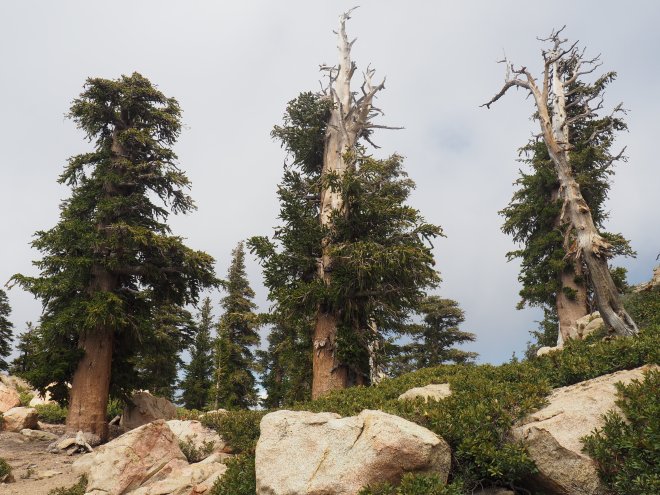
Sierra foxtail pine
photo © Nina House
*PIxley Vernal Pool Trip Returns on April 2!
We’re going ahead with the Pixley Vernal Pools event. Mary Merriman assures us that the roads are passable and that the flowers are popping with all the rain. The timing has changed to from 1-3 pm, but all other details remain the same. See below for details and directions to Pixley Vernal Pools Preserve.
Join Alta Peak Chapter of CNPS for a morning of exploring Pixley Vernal Pools Preserve, a small
relatively unknown remnant habitat of 40 acres, where we will photograph and ID as many
plants as possible. A historical plant list will be provided to participants and we may be able to
add to it or to discover which plants are no longer there.
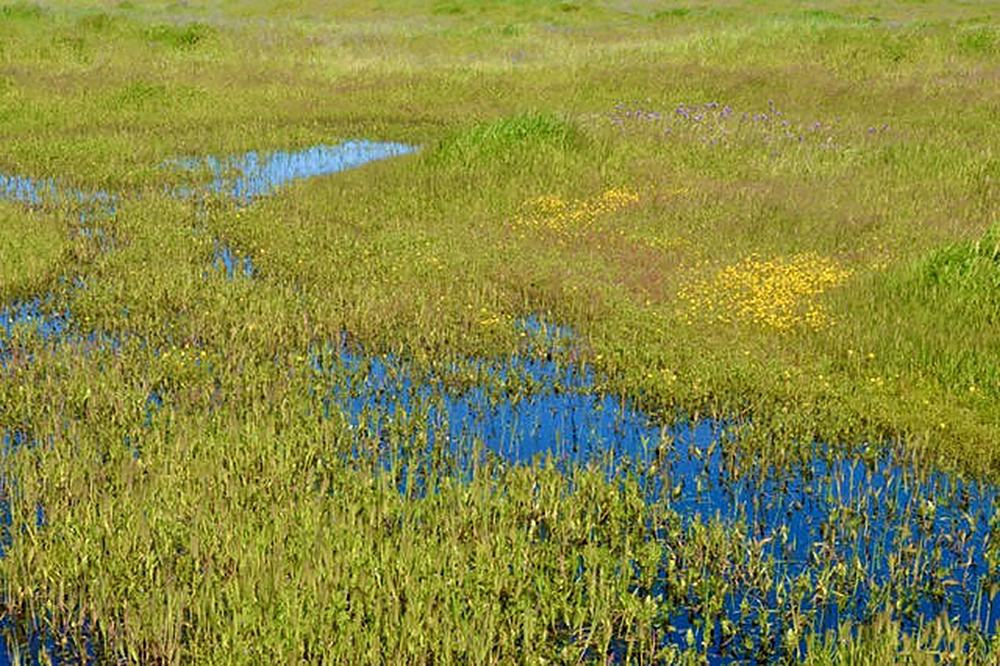
photo from Mary Merriman
Vernal pools, small jewels of diversity in a sea of monoculture, are rare remnants of a previously
common habitat in the Central Valley. These pools are underlain with a layer of hardpan–impermeable clay soils–where rainwater remains for weeks or months after storms come
through. They are preserved in only a few locations in Tulare County because most of the
hardpan was deep-ripped for agriculture. A unique biome of fairy shrimp, spade foot toad and
small delicate plants have evolved here. In spring, these plants can bloom in rings around the
pools, layers of blue Downingia close to the water, then swales of Goldfields species and
Popcorn Flower. Uncommon flowers thrive here and these pools have not been heavily
documented.
The ground is uneven and may also be wet so you may want to bring walking sticks and shoes
that can get wet. Bring layered clothing appropriate for the weather, sun protection, water and
snacks and your “looking eyes”. We will try not to trample the pools. Binoculars can be helpful.
Directions from the north from Hwy 99: Take the exit for Ave 120, going east (left) to Rd 152.
Rd 152 is signed as J15 on Google. Turn south (right) on Rd 152. Continue on Rd 152 to Ave
104. It is a tiny sign so be on the lookout. On Ave 104 turn east (left). The first paved road
going north on the left is Rd 160. There are almond trees on all 4 corners in different ages and
an ag pond on the right. There is no street sign so we will put out Alta Peak sandwich board at
the intersection. Turn north (left) here. In about a quarter mile you will see a field of grass on the
right. This is the Preserve. It is OK to park in the wide dirt on Rd 160
From Porterville or Springville, follow Hwy 190 to the intersection with Rd 152 (J15). Turn south
and follow the above directions from Rd 152.
From the south on 99, take the Terra Bella Ave exit, (Ave 96 or J24). Go east (right) to Rd 152
and turn north (left). Turn east (right) on Ave 104. Turn at the first unmarked but paved road to
the north (left)
We appreciate an RSVP but that is not required.
We do require signing a waiver of liability on site.
Contact person is Mary Merriman at 559 679-9152.

The Alta Peak Chapter is having a Spring Online Plant Sale!
The Online Plant Sale will run from Thursday, March 10 through Friday, March 18.
The plant sale online link will go live on March 10 at 10 am.
Order plants at this Online Link.
Current CNPS Members will get 10% off plant purchases!
The plant list is sourcing native plants from four nurseries, all from Tulare County. There are 85 species on the list and 42 of them are propagated from our local natives! In addition, we have for the first time plants from specific places, such as the Kaweah River and Tule Rivers Watersheds, and Sequoia Riverlands Trust Preserves.
Plant pickup will be at the Dry Creek Preserve in Woodlake on Saturday, March 26 from 10 – 2. Details at checkout.
Still need to join CNPS? First-time members can get 40% off CNPS membership. Use this link to join and get the special rate (discount applied at checkout). Join Link
Previously a member? Renew your membership here. Renew Link
If you join CNPS or have recently renewed your membership, email us for the special code. Current members received a code already.

This is Diplacus aurantiacus ssp. calycinus.
It will be available at the sale sourced from three different locations:
Kaweah R. and Tule R. watersheds, and from Dry Creek Preserve.
The Online Native Plant Sale will run from Saturday, September 18 at 10 am — Friday September 24 at 2 pm. We recommend that you shop early, as quantities are limited.
*The full plant list will not show up until Saturday when the sale is live.*
The website is now available for viewing, and you can view a pdf of our online plant sale list here that contains information about locally native plants. Use Calscape and Calflora to learn more about the plants on the list.
Because more than one CNPS chapter is having an online plant sale using this site, it may be somewhat confusing. See below for specific instructions about making purchases online.
Note: because of the fire in the National Park, our pickup site has been moved to Kaweah Oaks Preserve (east of Visalia on Highway 198). You will have an option at checkout to schedule a pickup inSpringville by special arrangement.
Please check out the following plants on our plant list. We’ve tried to have some important and interesting plants to offer. Use Calscape to learn more about almost all of our plants. Among them please note:
Contact: altapeakcnps1@gmail.com

Melica californica on River Ridge Ranch in Springvilla, © Barbara Brydolf
You may not have heard from us, but that doesn’t mean we’re not still alive and kicking. We’re going to jump start our re-aquaintance with an Online Native Plant Sale this month, from September 18-24, 2021, with in-person pick up after. This year we’re featuring locally sourced local native plants. Included in this email is information on the plant sale, why plant local natives (local locals).
Here is a Plant List for the sale.
Contact: altapeakcnps1@gmail.com

Apocynum androsaemifolium, spreading dogbane
© Barbara Brydolf
The Tule River Native Plant Demonstration Garden Project planted seventy-eight native plants on November 9, 2019. The Project hosted a workday at which three gardens were planted.
The Burton School District Garden volunteers planted thirty-four plants in root baskets. All eight species were California Native Plants and were selected to flourish in our climate with minimal irrigation once established. The volunteers moved rocks into place, completed the cleaning of the garden site, built root baskets to protect each plant from gophers, and using the training provided by the project, carefully planted thirty-four native plants.
The Alta Peak Chapter of the California Native Plant Society volunteers added fourteen plants to the garden they had started on November 2, 2019. Alta Peak volunteers also removed seven trees that had died from various causes over the years prior to the groups adoption of the site.
Jesse Bejarano with the help of other group volunteers planted thirty plants in root baskets. His garden design includes sixty-one native plants and was designed as a scent garden.
Volunteers from the three groups plus the Tule River Parkway Association contributed 106 combined hours of labor. This was the biggest single day of planting yet at the project.
The project has garden sites ready to adopt and encourages local groups or families to participate. The project supports the gardens with all needed plants and equipment through a grant partnership with US Fish and Wildlife and the City of Porterville.
The next planting day is Saturday, November 30, from 9 am to noon.
Meet at the Jaye Street parking lot on the south bank of the Tule River at the Jaye Street Bridge.
Cathy Capone — 559-361-9164
tulerivergarden@gmail.com
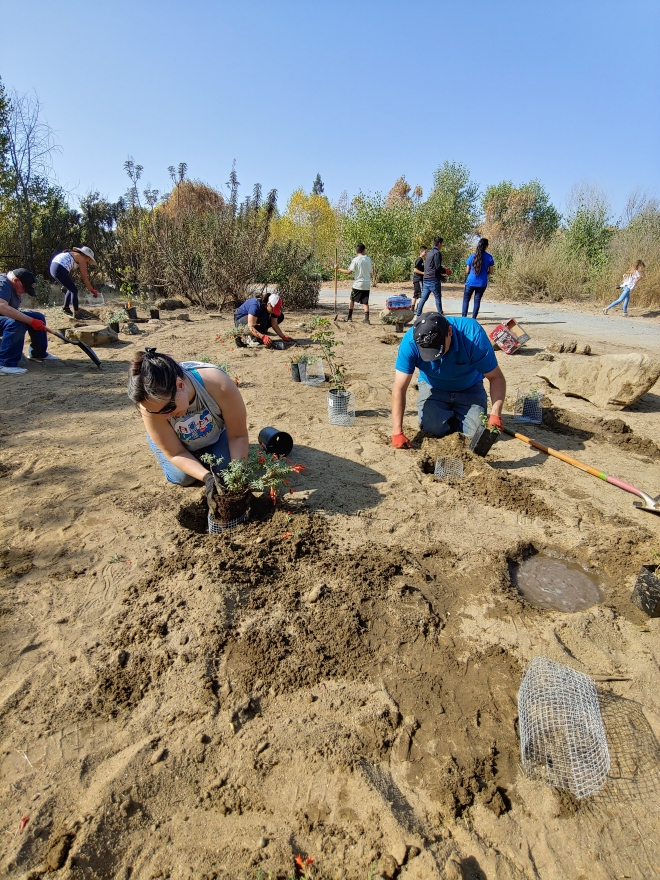
[photo via Cathy Capone]
Saturday, October 5, 2019 from 9 am—2 pm
Three Rivers Arts Center
41763 North Fork Dr., Three Rivers, CA 93271

Bush lupine photo from Melanie Keeley
Because autumn is the best season to plant California native plants, we will once again be bringing to you a wide assortment of beautiful, hardy native plants! More than anyone, our chapter members realize that native plants succeed and thrive in the foothills of the Sierra Nevada. Well-chosen drought tolerant native plants are survivors, having adapted to this sometimes unforgiving climate. These plants fit both aesthetically as well as physiologically. Each bit of created habitat as well as protected wild lands provide critical food and shelter that sustains the varied wildlife dependent on it.
CNPS members receive a 10% discount on plants and 20% off book purchases. Join HERE.
Pre-Order Plant Sale Forms (for members only) and deposits are due September 14, 2019.
Send pre-orders with deposit to: Alta Peak CNPS, PO Box 217, Three Rivers, CA 93271.
Plant order pick up will be on the day of the plant sale—Saturday, October 5, 2019 after 9 am.
We appreciate your support!
*Please Note: Native plants will also be available for purchase at the Annual Foothills Festival on Saturday November 2nd at River Ridge Ranch in Springville.
This field trip will be a 4.5 mile round trip, with an elevation gain of 1000 ft, moderately strenuous four hour wildflower hike on a dirt road up to the forebay of the Tule River at the Hydroelectric Complex at the junction of Hwy 190 & 208. We expect to see a great wildflower display, and an opportunity to view the regrowth of a recently burned area.
Meet at Springville Community Park in Springville on Hwy 190 at 9:00 am. Bring at least two liters of water and a bag lunch. Chapter field trips are open to everyone.
For more information, contact Cathy Capone 559 361 9164 or cathycaponemail@gmail.com

Upper Tule River, photo from Cathy Capone
Offered by the Alta Peak Chapter of the California Native Plant Society (CNPS)
with California native plant specialists,
Melanie Keeley, CA Native Plant Horticulturist & Sequoia/Kings Canyon NP Botanist
Cathy Capone, Alta Peak Chapter Horticulture Chair and Garden Ambassador
Held at College of the Sequoias in Visalia, location details given with registration
Design your native plant landscape with the help of local experts at this spring workshop on landscaping with drought tolerant native plants. Participants will be treated to an informative, colorful presentation that will highlight the benefits of using native plants in the residential landscape, including principals of landscape design, and how to best combine native plants for compatibility and extended blooming in your landscape.
Following the presentation, participants will be provided drafting supplies and will additionally be given printed handouts and resources to refer to. Students will then be guided by Cathy and Melanie who will help in the selection and arrangement of the best native plants for your situation, giving you a low water, low care garden design of your own.
Native plants can be used to create any style in your garden – from cottage style to formal. You choose the design that suits your house, esthetic, and garden requirements. Design the garden to complement your home and your taste, using California climate-adapted native plants which require a lot less water and maintenance. Switching to native plants saves on water, fertilizer, pesticides, time and effort.
Spring is a perfect time to design a garden. You will have time, ahead of the fall prime planting time for native plants, to prepare your landscape for the change to a low-care, low-water use, pollinator friendly garden.
Pre-registration is required. Class size is limited.
CNPS Members — $55, $45 (early-bird special, enrollment by May 1)
Non-members — $75, ($65 early-bird special, enrollment by May 1)
Contact Melanie Keeley at 559-799-7438 to register.
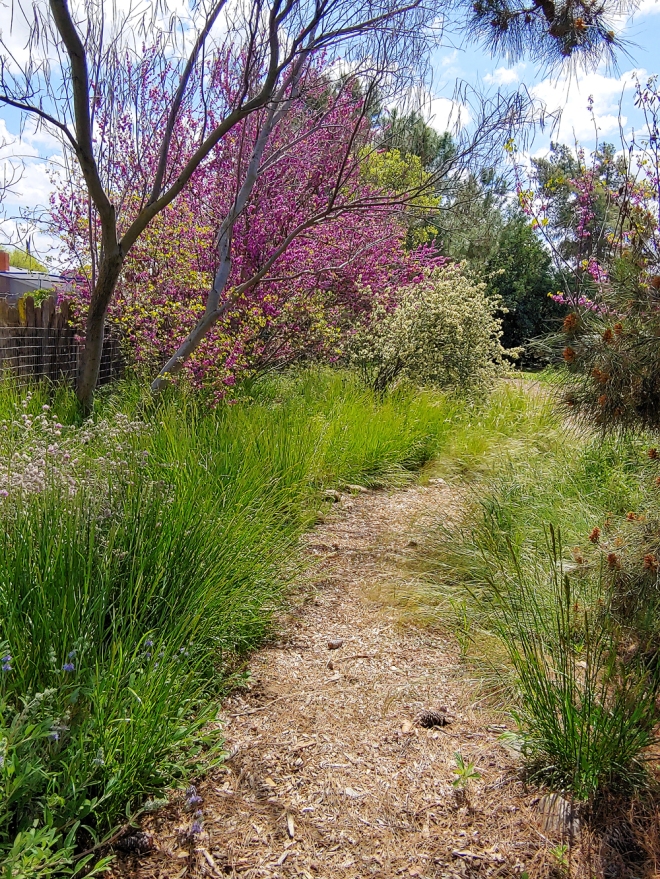
Native garden photo from Cathy Capone
Did you know that California has more native plant species than any other state in the nation? California’s incredible plant life makes it not only one of the most beautiful places on Earth but also among the most important contributors to the world’s biodiversity. That’s why, in 2010, the California State Legislature designated the third week of April to be California Native Plant Week. 2019’s celebration is April 13-21.
Now, we celebrate this important week each year with a wide variety of events up and down the state, including guided hikes, lectures, native plant sales, garden tours, and more!
When you save plants, you save everything else. That’s the message behind this year’s CA Native Plant Week campaign. Native plants provide vital habitat, food, and ecosystem services for pollinators, wildlife, and humans alike. And every plant matters, especially in California, one of the world’s global biodiversity hotspots. Help us spread the word online with hashtags: #NativePlantWeek #CNPS #bioDIVERSITY. Visit the CNPS campaign landing page and see listings for our many local chapter events around the state.

Tejon in bloom, photo by Nick Jensen, CNPS Southern California Conservation Analyst.
Tejon Ranch in Southern California is under threat by the Centennial development – a proposal to place a city of 55,000 people here despite high wind, fire, and earthquake risk, and the irreplaceable loss of some of our last pre-European grassland habitat.
Saturday March 23, 2019 from 9am-12
Tule River Parkway in Porterville
Enjoy the native vegetation along the Tule River and learn how to use Observer Pro, a smart phone app, which provides a platform in which to upload plant observations to CalFlora. The group will meet in the Jaye Street parking lot just south of the Jaye Street Tule River bridge. Cathy Capone will give a brief presentation on CalFlora, the website where the Observer Pro observation data is stored. She will then take the group on a walk in the riparian forest, while demonstrating and coaching participants to input their observations.
To find the location, enter the parking lot while traveling south on Jaye Street immediately after you pass the bridge railing. Bring water and wear sturdy shoes. Event will be held rain or shine. There are no bathrooms available at the event. The walk will be on a paved path with the option to walk into the natural areas for close observations. The walk is under a mile in length and includes an elevation gain of less than 50 feet.
To make full use of the training, log in to calflora.org and register as a contributor. Then download the Observer Pro app to your phone. There is no charge for the workshop or the app. Cathy Capone is an officer of both the Tule River Parkway Association and the Alta Peak Chapter of the California Native Plant Society.
For more information, contact her at 559 361 9164 or tulerivergarden@gmail.com
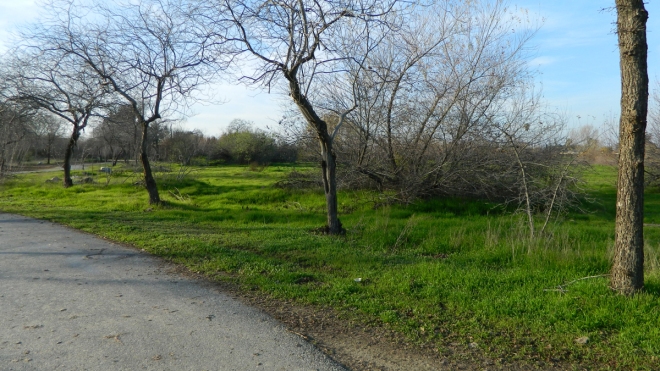
With help from Calscape, the Alta Peak Chapter has chosen some native plants that could work well in our local landscaping projects and home gardens.
Here are the pdf files:
Native Landscape Planting Guide to read online HERE.
(note: it may take extra time to load pdf file.)
Native Landscape Planting Guide to print as a hardcopy HERE.
(note: print both sides on one sheet of 11×17 inch paper and fold in half.)
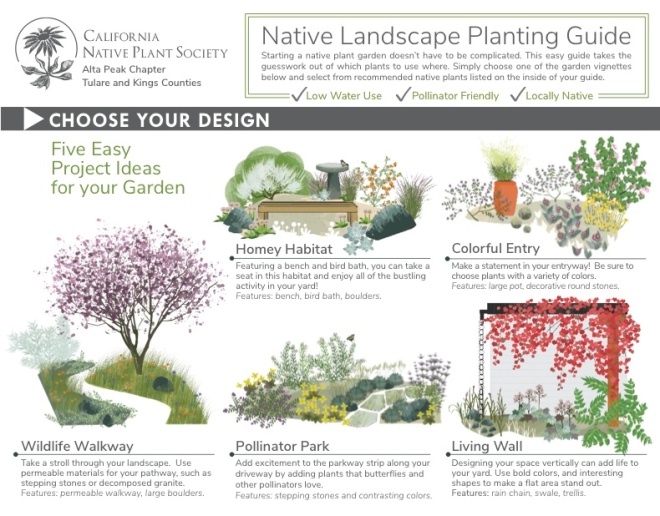
Cathy Capone will be leading a citizen science project to document the plant populations along the Tule River Parkway path in Porterville. Part of the Tule River Parkway Association’s plans to preserve and restore the Tule River riparian corridor is to document the existing vegetation, both good and bad.
Cathy will be using and demonstrating the use of Observer Pro to document locations of plants along the paved paths. Observer Pro is an application for smart phones that allows you to quickly and efficiently report wild plant occurrences. This application makes it easy for you to report the species name, date, and location of over 10,000 California native and non-native plant taxa. You can also add a photograph to a report and share it with others later to confirm identification. Your reports are transmitted wirelessly to the Calflora database, where you can edit them and see them on a map.
Download the app Observer Pro before the walk if you want to learn on your own device. Meet at the trail entrance lot off Jaye Street. Enter from southbound lanes just south of Tule River Bridge rail. Easy walk 1 mile, no elevation gain. Wear closed toe shoes, bring water, no restrooms are available.
For more information, email tulerivergarden@gmail.com or call Cathy Capone at 559-361-9164.

Alta Peak Chapter Horticulture Chair, Cathy Capone, will lead this walk, designed to highlight the native vegetation along the Tule River and to discuss plans to enhance the area. The walk will be on an easy, flat, paved trail that is wheelchair accessible. The walk is free and open to the public.
The Tule River Parkway Association, in cooperation with the City of Porterville, Partners for Fish and Wildlife, and the Alta Peak Chapter are working to preserve and restore the Tule River riparian corridor in Porterville. The plan is to develop the Tule River Parkway path for public use and to install eighteen native plant landscape gardens. Alta Peak Chapter has pledged to adopt one of these gardens and looks forward to participating in the restoration of the natural riparian landscape.
Wear closed-toed shoes, bring water, and make not that no restrooms are available. Meet at the Tule River Parkway in Porterville on Jaye Street, just south of the bridge over the river. Access is from the south bound lane only- no left turns are allowed at that location, so north bound traffic should make the first available U-turn on Jaye Stree.
Call Cathy Capone at 559-361-9164 or email at tulerivergarden@gmail.com for more information.

Alta Peak Chapter will be joining other horticulture-related booths in the Garden Center area of the 26th Annual Springfest Home and Patio Show at Visalia Convention Center. The Chapter will be there to spread the word about native plants and their uses in the personal garden landscape. Find books about native plant gardening and identification, California wildflower posters, and some native plants.
Hours: Fri 11-6 pm, Sat 10-7 pm, Sun 10-5 pm
Contact Barbara Brydolf at bbrydolf@gmail.com for more information.
We will need help from Chapter members at the booth during the open hours and for set up and take down. Contact Barbara to sign up.

Celebrate nature with music, food, a native plant sale, crafts and walking tours from 10-4 pm. The festival is free and is held at the River Ridge Ranch, located at 37675 Balch Park Road, Springville. Alta Peak Chapter will be there!
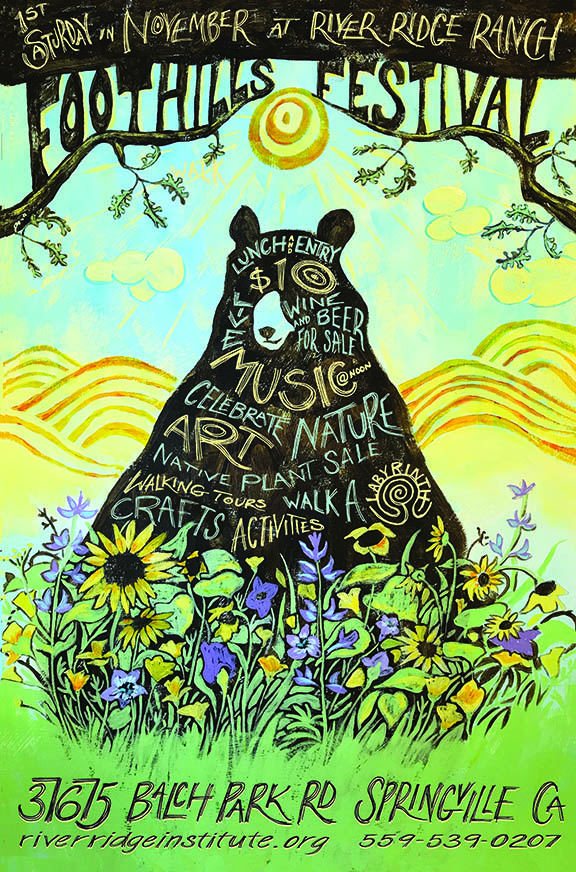
“Explore Calflora’s Native Plant Database”
presented by Cynthia Powell, Executive Director Calflora
St. Anthony Retreat, Mission Room 43816 Sierra Dr (Hwy 198), Three Rivers
Learn about new Calflora tools for Calflora users. Calflora’s plant database hosts over two million plant occurrences, some of which have come directly from Alta Peak members. Powell will go over Calflora’s new plant photo project, planting guide, population monitoring tools, email alerts, and speak more generally about the uses of Calflora for CNPS chapters. She would also like to know how Calflora can better serve the Alta Peak Chapter and to answer any of your questions.
After 3 years as Calflora’s GIS Project Manager, Cynthia is now Calflora’s Executive Director. She graduated with her MS in GIS in 2010 forecasting Mokelumne River water supply based on MODIS remote sensing snow pack images. She’s been examining what was under that snow — plants — ever since. She now coordinates all Calflora programs, research, outreach, and advocacy, as well as fundraising and management.
The Calflora Database is a nonprofit organization dedicated to providing information about California plant biodiversity for use in Education, Research and Conservation. Calflora is structured as a digital library to fulfill the following objectives:
Calflora relies on contributors for the information it provides; the website reflects the work of many individuals and institutions.
Join Cynthia Powell for a hands-on plant data collecting field trip for Calflora.
Meet at 8:45 am at Three Rivers Veterans Memorial Building on Hwy 198.
Actual field trip location TBA, in the foothills. Field trip will go to around 2 pm.
from Alta Peak Chapter President, Barbara Brydolf: Did you ever go to a place and look around you, wondering what all those plants are? I certainly have. And I have friends who, mistakenly thinking I’m a plant expert, send me photos of plants to identify. Fortunately, there is a great website and app, called Calflora, for finding out exactly that. Calflora is a nonprofit organization that catalogs California plants by location, genus, common name, and a host of other search terms. I use it more than any other resource to anticipate what I will find in a certain place, and to identify a plant I don’t know. Calflora has catalogued thousands of plant records from all over California, and continues to add information through citizen science, which means that anyone can contribute to the knowledge of what grows here. Our own Mary Merriman, with her Rare Plant Surveys, has made contributions to this site. Calflora is a rich tool, and I know that there are many features that I have not used, not to mention the phone app I haven’t even downloaded yet. That’s why I’m excited that Cynthia Powell, is coming here to Tulare County to give a talk about using the website and app, and to lead a hike the following day. I hope you can join us for this unique opportunity to learn more about native plants!
 photo: Lewis Hill Preserve near Porterville CA © Sequoia Riverlands Trust
photo: Lewis Hill Preserve near Porterville CA © Sequoia Riverlands Trust
From calflora.org:
There’s a lot more to Calflora than these basic tools — you can learn about Calflora’s more advanced features at the top of this page, where you will find links to many web applications concerning California plants.
Go east on Hwy 198 to Three Rivers, turn left at Anne Lang’s Emporium.
Look for the first building on the left on North Fork Drive.
Alta Peak Chapter is back again with its tremendously popular, annual fall plant sale.
Make sure to come early for the best selection.

While California’s native plants have graced gardens worldwide for over a century, few of the landscapes designed for our state’s gardens reflect the natural splendor for which California is famous. By gardening with native plants, you can bring the beauty of California into your own landscape while also receiving numerous benefits. In a garden environment, native plants do best with some attention and care, but require less water, fertilizer, pruning, less or no pesticide, and less time to maintain than do many common garden plants. The plant sale features high-quality native plants from Intermountain Nursery, which are better suited to the local climate than plants from the coastal nurseries.
Chapter members will receive a 10% discount on all plants and can pre-order plants.
Download plant pre-order form for members. • LINK HERE • Deadlne is September 22.
The chapter needs many volunteers to help with set-up on Friday at 10:30 am
and/or during the plant sale on Saturday from 10 – 3 pm.
If you wish to volunteer, please contact Melanie Keeley at 559-799-7438 for more information.
Saturday, October 27, 2018 from 9-2 pm
College of the Sequoias in Visalia
presented by Melanie Keeley,
Native Plant Specialist, Sequoia/Kings Canyon National Parks
and Cathy Capone, former owner of Cal Natives Nursery in Porterville,
Alta Peak Chapter Horticulture Chair
More details and registration information • LINK HERE •
Saturday, August 27, 2018 from 9-2 pm
College of the Sequoias in Visalia
presented by Melanie Keeley,
Native Plant Specialist, Sequoia/Kings Canyon National Parks
and Cathy Capone, former owner of Cal Natives Nursery in Porterville,
Alta Peak Chapter Horticulture Chair
With California’s unpredictable precipitation, it is time for new landscape style that will work in this hot, arid climate. California native plants use a fraction of the water that typical garden plants do, while being attractive and colorful as well. Designed for native plant novices, this class will help you learn practical applications related to 1) ditching your lawn, 2) tried and true native plants, 3) combining native plants for maximum color and effect, and 4) how to design your own drought tolerant native garden. Once a landscape plan is in place, the landscape can be installed in manageable steps. This class provides a great opportunity to transition from a high care, water indulgent garden into a natural, sustainable low water use, beautiful garden.
Registration Fee CNPS Members – $45, Non-members – $60
Pre-registration is required. Class size is limited.
Call Melanie Keeley at 559-799-7438 to register.
By joining the Alta Peak Chapter of the California Native Plant Society during the clinic, you will be eligible to pre-order your chosen native plants prior to our October 6, Annual Fall Plant Sale at a 10% discount.

photo of CA native annuals in the garden by Melanie Keeley
July 21, 2018 from 8 -3 pm
Lead by Barbara Brydolf, Alta Peak Chapter President
Come explore a Giant Sequoia Grove in the Sequoia National Monument above Springville. In the heat of summer, find shelter under the canopy of the giants. We will explore either the Wheel Meadow Grove above Camp Nelson or the Black Mountain Grove near Mountain Aire. We may see mountain misery (Chamaebatia foliolosa), thimbleberry (Rubus parviflorus), Hartweg’s wild ginger (Asarum hartwegii), and could see California tiger lily (Lilium pardalinum), stream orchid (Epipactis gigantea), scarlet bugler (Penstemon centranthifolius), and Scouler’s St. John’s wort (Hypericum scouleri).
Meet at the Springville Veterans Memorial Park, on the right side of Hwy 190 between Gifford’s Market and the Fire Station in downtown Springville. We will carpool and caravan up the highway. Expect as much as a five mile hike over varied terrain and elevations around 4500-5500 feet.
Bring lunch and water. Wear sturdy shoes and be prepared for sun and mosquitoes.
For more information, contact Barbara Brydolf at bbrydolf@gmail.com or 559-359-2827.

photo via Valley Public Radio
fron an episode of Here and Now with Ezra David Romero,
Saturday, June 23, 2018 from 8:30 am – early afternoon
Lead by Mary Merriman, Alta Peak Chapter Rare Plant Chair
and Denise Griego, Alta Peak Chapter Secretary
Explore the high altitude flora of Sequoia National Forest Hume Lake District, located between Giant Forest and Grant Grove. Big Meadow has the highest altitude with accessible roads in Tulare County. Its subalpine flora is dominated by lodgepole pine, white/red fir forest on exfoliated granite. It will still be late spring there! We may find a few relatively rare plants, such as Tulare County buckwheat and Sierra bleeding heart and we may find several kinds of monkey flowers although they are more unpredictable in dryish years. Wet meadows hide many floral treasures throughout the season. Shady stream banks harbor a variety of shrubs.
From Three Rivers area, meet at the Veterans Memorial Building on Hwy 198 at 8:30 am for carpooling. Try to bring the fewest number of cars possible. From Visalia area, we will be taking the shorter route up Hwy 180 through the Kings Canyon entrance. If you are coming from Visalia area, contact Mary Merriman at 559-679-9152 or marymtnspirit@gmail.com for directions up Hwy 180 or for ride-sharing, especially if you do not have a park pass. There is now a $35 entrance fee to the National Parks, so be sure to bring your annual or senior pass.
Meet on the Big Meadow road at 10:30 am at the first parking lot (map link here). There is only one way to turn at the Big Meadow Road but it has a fairly small sign. About 1/4 mile up the Big Meadow road, there is a gate (which will be open) and large parking lot on the right with an outhouse where we will start. We will mostly be driving or walking with no significant hiking but plenty of uneven ground so wear sturdy boots. Bring lunch, water, sunscreen, hat, layered clothing (mornings can be cool), field guides and a lawn chair for lunch.
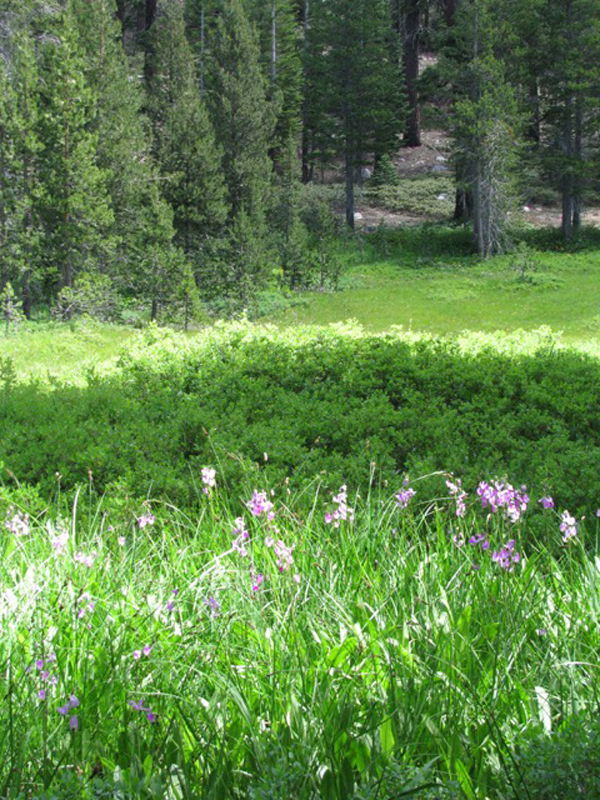
Big Meadow photo by Denise Griego
Saturday May 12, 2018 from 8 am – 12 noon
Sponsored by the Tule River Parkway Association, Noon Rotary of Porterville, City of Porterville,
Porterville Unified School District and Alta Peak Chapter of the California Native Plant Society
Help is needed to advise teams of high school students as they plant 23 or more native trees along the Parkway path, including valley oak, California sycamore, western redbud, and Fresno ash. Please wear sturdy shoes and wear sun protection. If possible, bring a shovel to share. Water will be provided.
Meet at at the Sears parking lot on Jaye Street just south of the river in Porterville.
For more information, and to sign up, please contact Cathy Capone at cathycaponemail@gmail.com or 559-361-9164.

[photo of redbud branch in bloom © Cathy Capone]
Sunday, March 25, 2018 from 9:30 – 12:30 pm at the River Ridge Ranch in Springville
Gary Adest of River Ridge Institute, Alta Peak Chapter President Barbara Brydolf, and forest experts Nina Hemphill and Ernie Garcia will lead this field trip to see how the Pier Fire has changed blue oak (Quercus douglasii) woodland on the lower slopes of Lumreau Mountain. We will explore the effects of the fire on soil, vegetation, and wildlife, and discuss the function of fire in the landscape. Expect to see wildflowers on this walk.
Meet at 9:30 am in the lower parking lot of River Ridge Ranch, located at 37675 Balch Park Rd, on the east side of the road, 1.6 mi. north of the White Barn in Springville. The walk will be moderately strenuous, approximately 5 miles, with a 1000’ elevation gain. Bring lunch and water and dress appropriately.
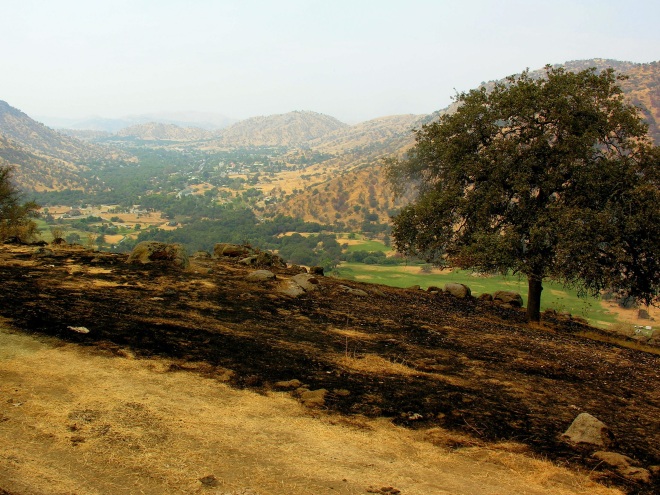
[photo credit: River Ridge Institute]
Tule River Parkway Association Meeting
March 13, 2018 at 5:30 pm
Porterville Historic Museum (located at 257 North D Street in Porterville)
The Tule River Parkway Association (TRPA) invites anyone to attend this meeting, who is interested in preservation and restoration of the Tule River riparian corridor. TRPA will discuss partnering with the City of Porterville to submit a grant proposal to the US Fish and Wildlife Service. The proposal will include plans for development for public use and for the installation and maintenance of eighteen native plant landscape gardens along the Tule River Parkway path. A landscape plan with specific native plants, to be planted in the cool months only, will be part of the grant proposal. Public input is welcome. The Alta Peak Chapter of the California Native Plant Society enthusiastically supports this project.
For more information, email tulerivergarden@gmail.com or call Cathy Capone at 559-361-9164.
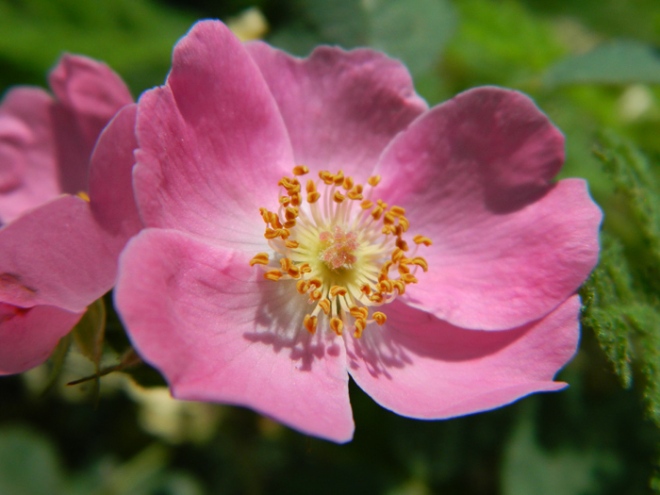
[“California Wild Rose” photo © Cathy Capone]
Alta Peak Chapter events are free and open to the public.
Saturday, February 24, 2018 at 7pm (social time starts at 6:30)
Chapter Winter Program
“Adaptation of Plants, Animals and Humans to Wildfires:
What to Expect Following the Pier Fire”
with Dr. Jon Keeley, fire ecologist/research scientist for the United States Geological Survey
and adjunct professor UCLA
Springville Veterans’ Memorial Building on Hwy 190
Wildfires are a necessary part of the ecology of many wild landscapes in mediterranean-type climates across the globe, promoting healthy wildlands and biodiversity. After an explosive fire year in California, many questions arise as humans more commonly move into areas that are subject to burning. Dr. Keeley will provide an overview of the fire history of Sierra Nevada forests and shrublands, describing interesting ways plants and animals have adapted to survive wildfires. This talk will touch on important issues related to the wildland-urban interface, as well as the future in an era of global change.
Saturday, February 24, from 1-4 pm
Field Trip: Pier Fire Area
before Winter Program in Springville
Led by Jon Keeley and Barbara Brydolf, this field will be mostly driving along Hwy 190 above Springville with stops at various overlooks, and a short hike on steep terrain (this could be skipped by people who want to go on the excursion, but are unable to do the hike).
Meet at the Springville Veteran’s Memorial Building at 1 pm to caravan and carpool. Carpooling is encouraged, as pull-outs along Hwy 190 are limited.
After the field trip and before the program, join Chapter members for dinner at Nuevo Mexicali III restaurant in Springville, located at: 35258 Hwy 190.
The Alta Peak Chapter will hold its annual native plant sale on October 7, 2017, from 10-3 pm at the Three Rivers Arts Center on North Fork Drive. Chapter members will be admitted at 9 am for an earlybird opportunity to select plants. Also, Chapter members can pre-order plants at a 10% discount. Download pre-order form HERE.
Join the California Native Plant Society as an Alta Peak Chapter member at cnps.org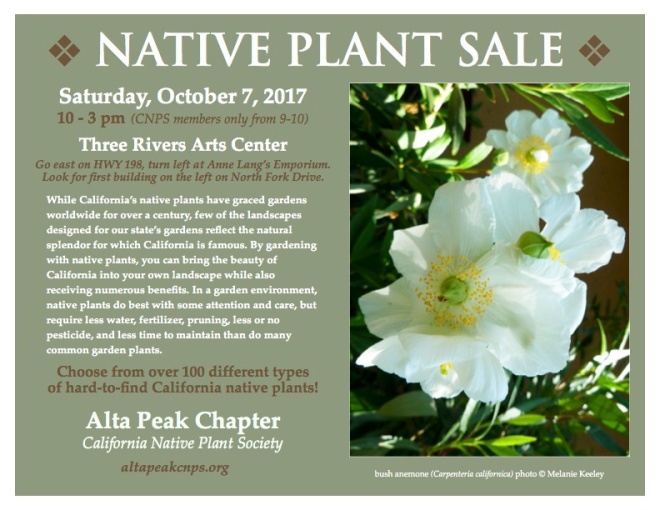
Plant photos by Melanie Keeley, from left to right:
yerba mansa (Anemopsis californica)
deergrass (Muhlenbergia rigens) and Idaho bluegrass (Festuca idahoensis)
Douglas iris (Iris douglasiana)
Saturday, August 26, 2017, from 9-2 pm
Instructors: Melanie Keeley and Cathy Capone
College of the Sequoias in Visalia
(exact room will be given at time of registration)
Registration Fee: CNPS Members – $45, Non-members – $60.00
Pre-registration is required. Class size is limited.
Call 559-799-7438 for registration as well as questions.
The traditional garden of expansive lawns, and lolly-popped shrubs are a thing of the past. With California’s unpredictable precipitation, it is time for a new model that will work in this hot, arid climate. California native plants not only use a fraction of the water that typical gardens do, they are attractive and colorful as well. In this class, designed for native plant novices, we will help you learn
With a plan in place, you can landscape your garden in manageable steps. It’s an opportunity to transition from a high care, water indulgent garden into a natural, sustainable low water use, beautiful garden.
By joining CNPS at this time, you’ll be eligible to pre-order native plants for the Annual Fall Plant Sale (October 7) at a 10% discount.
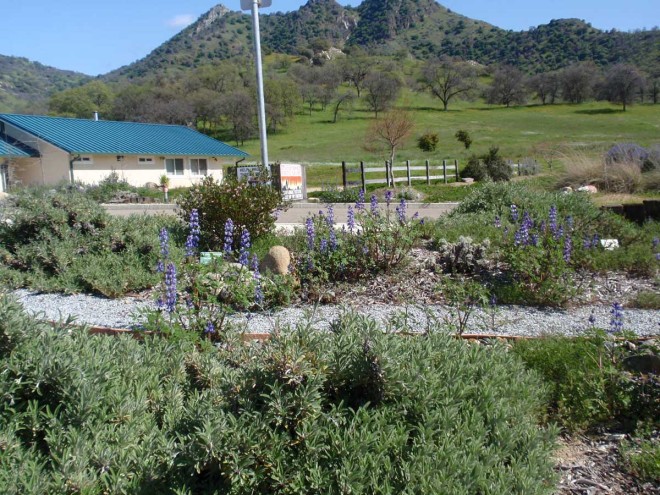
Native Plant Garden at the CAL Fire Station in Three Rivers, California
Created and supported by the Redbud Garden Club, maintained by firefighters